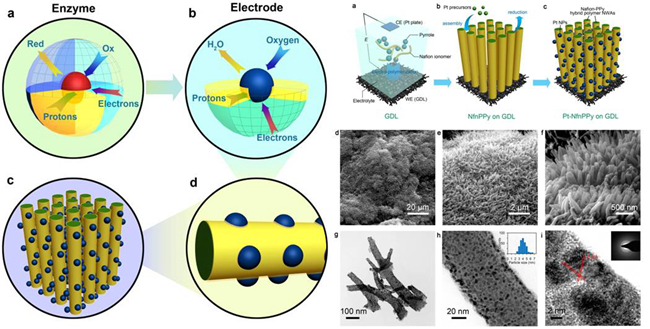Recently, Dr. Zhangxun Xia et al. form the Division of Fuel Cell & Battery led by Prof. Gongquan Sun has made new progress in ordered nanostructure for polymer electrolyte membrane fuel cells. Inspired by the catalytic microstructure of enzyme, they were first to construct ordered triple-phase boundaries for oxygen oxidation reactions in nanoscale with high efficiency and durability. The mass activity of PEMFC exceeded the Department of Energy’s target for 2015. This work is recently published in Scientific Reports(doi:10.1038/srep16100)

DICP Researchers Firstly Construct Ordered Triple-Phase Boundaries for Oxygen Oxidation Reactions in Nanoscale with High Efficiency and Durability(Photo by Zhangxun Xia, Suli Wang)
The significant use of platinum for catalyzing the cathodic oxygen reduction reactions has hampered the widespread use of polymer electrolyte membrane fuel cells. The construction of well-defined electrode architecture in nanoscale with enhanced utilization and catalytic performance of Pt might be a promising approach to address such barrier. Inspired by the highly efficient catalytic processes in enzymes with active centers embedded in charge transport pathways, here we demonstrate for the first time a design that allocates platinum nanoparticles (Pt NPs) at the boundaries with dual-functions of conducting both electrons by aid of polypyrrole and protons via Nafion? ionomer within hierarchical nanoarrays. By mimicking enzymes functionally, an impressive ORR activity and stability is achieved. Using this brand new electrode architecture as the cathode and the anode of a PEMFC, a high mass specific power density of 5.23?W?mg?1Pt is achieved, with remarkable durability. These improvements are ascribed to not only the electron decoration and the anchoring effects from the Nafion? ionomer decorated PPy substrate to the supported Pt NPs, but also the fast charge and mass transport facilitated by the electron and proton pathways within the electrode architecture. (Text and photo by Zhangxun Xia, Suli Wang)